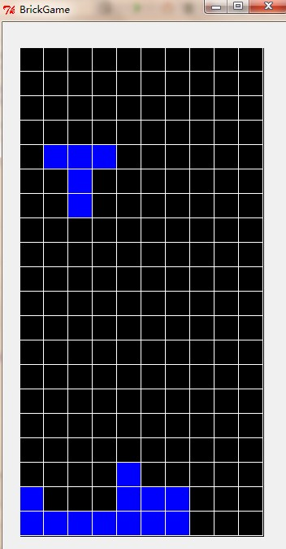Python写的俄罗斯方块
发布时间:2019-09-05 07:07:48编辑:auto阅读(1809)
在公司实习。公司推崇Python和Django框架,所以也得跟着学点。
简单瞅了下Tkinter,和Canvas配合在一起,还算是简洁的界面开发API。threading.Thread创建新的线程,其多线程机制也算是方便。
只是canvas.create_rectangle居然不是绘制矩形,而是新建了矩形控件这点让人大跌眼镜。先开始,在线程里每次都重绘多个矩形(随数组变化),其实是每次都新建了N个矩形,结果内存暴增。原来,对矩形进行变更时,只需用canvas.itemconfig即可。
下面就是截图(时间太晚,明日还得上班,做得非常粗糙...没事时再慢慢修正)。

而代码如下:
#coding=utf-8
from Tkinter import *;
from random import *;
import thread;
from tkMessageBox import showinfo;
import threading;
from time import sleep;
class BrickGame(object):
#是否开始
start = True;
#是否到达底部
isDown = True;
#窗体
window = None;
#frame
frame1 = None;
#绘图类
canvas = None;
#标题
title = "BrickGame";
#宽和高
width = 350;
height = 670;
#行和列
rows = 20;
cols = 10;
#几种方块
brick = [
[
[
[1,1,1],
[0,0,1],
[0,0,0]
],
[
[0,0,1],
[0,0,1],
[0,1,1]
],
[
[0,0,0],
[1,0,0],
[1,1,1]
],
[
[1,1,0],
[1,0,0],
[1,0,0]
]
],
[
[
[0,0,0],
[0,1,1],
[0,1,1]
],
[
[0,0,0],
[0,1,1],
[0,1,1]
],
[
[0,0,0],
[0,1,1],
[0,1,1]
],
[
[0,0,0],
[0,1,1],
[0,1,1]
]
],
[
[
[1,1,1],
[0,1,0],
[0,1,0]
],
[
[0,0,1],
[1,1,1],
[0,0,1]
],
[
[0,1,0],
[0,1,0],
[1,1,1]
],
[
[1,0,0],
[1,1,1],
[1,0,0]
]
],
[
[
[0,1,0],
[0,1,0],
[0,1,0]
],
[
[0,0,0],
[1,1,1],
[0,0,0]
],
[
[0,1,0],
[0,1,0],
[0,1,0]
],
[
[0,0,0],
[1,1,1],
[0,0,0]
]
]
];
#当前的方块
curBrick = None;
#当前方块数组
arr = None;
#当前方块形状
shape = -1;
#当前方块的行和列(最左上角)
curRow = -10;
curCol = -10;
#背景
back = list();
#格子
gridBack = list();
#初始化
def init(self):
for i in range(0,self.rows):
self.back.insert(i,list());
self.gridBack.insert(i,list());
for i in range(0,self.rows):
for j in range(0,self.cols):
self.back[i].insert(j,0);
self.gridBack[i].insert(j,self.canvas.create_rectangle(30*j,30*i,30*(j+1),30*(i+1),fill="black"));
#绘制游戏的格子
def drawRect(self):
for i in range(0,self.rows):
for j in range(0,self.cols):
if self.back[i][j]==1:
self.canvas.itemconfig(self.gridBack[i][j],fill="blue",outline="white");
elif self.back[i][j]==0:
self.canvas.itemconfig(self.gridBack[i][j],fill="black",outline="white");
#绘制当前正在运动的方块
if self.curRow!=-10 and self.curCol!=-10:
for i in range(0,len(self.arr)):
for j in range(0,len(self.arr[i])):
if self.arr[i][j]==1:
self.canvas.itemconfig(self.gridBack[self.curRow+i][self.curCol+j],fill="blue",outline="white");
#判断方块是否已经运动到达底部
if self.isDown:
for i in range(0,3):
for j in range(0,3):
if self.arr[i][j]!=0:
self.back[self.curRow+i][self.curCol+j] = self.arr[i][j];
#判断整行消除
self.removeRow();
#获得下一个方块
self.getCurBrick();
#判断是否有整行需要消除
def removeRow(self):
for i in range(0,self.rows):
tag1 = True;
for j in range(0,self.cols):
if self.back[i][j]==0:
tag1 = False;
break;
if tag1==True:
#从上向下挪动
for m in xrange(i-1,0,-1):
for n in range(0,self.cols):
self.back[m+1][n] = self.back[m][n];
#获得当前的方块
def getCurBrick(self):
self.curBrick = randint(0,len(self.brick)-1);
self.shape = 0;
#当前方块数组
self.arr = self.brick[self.curBrick][self.shape];
self.curRow = 0;
self.curCol = 1;
#是否到底部为False
self.isDown = False;
#监听键盘输入
def onKeyboardEvent(self,event):
#未开始,不必监听键盘输入
if self.start == False:
return;
#记录原来的值
tempCurCol = self.curCol;
tempCurRow = self.curRow;
tempShape = self.shape;
tempArr = self.arr;
direction = -1;
if event.keycode==37:
#左移
self.curCol-=1;
direction = 1;
elif event.keycode==38:
#变化方块的形状
self.shape+=1;
direction = 2;
if self.shape>=4:
self.shape=0;
self.arr = self.brick[self.curBrick][self.shape];
elif event.keycode==39:
direction = 3;
#右移
self.curCol+=1;
elif event.keycode==40:
direction = 4;
#下移
self.curRow+=1;
if self.isEdge(direction)==False:
self.curCol = tempCurCol;
self.curRow = tempCurRow;
self.shape = tempShape;
self.arr = tempArr;
self.drawRect();
return True;
#判断当前方块是否到达边界
def isEdge(self,direction):
tag = True;
#向左,判断边界
if direction==1:
for i in range(0,3):
for j in range(0,3):
if self.arr[j][i]!=0 and (self.curCol+i<0 or self.back[self.curRow+j][self.curCol+i]!=0):
tag = False;
break;
#向右,判断边界
elif direction==3:
for i in range(0,3):
for j in range(0,3):
if self.arr[j][i]!=0 and (self.curCol+i>=self.cols or self.back[self.curRow+j][self.curCol+i]!=0):
tag = False;
break;
#向下,判断底部
elif direction==4:
for i in range(0,3):
for j in range(0,3):
if self.arr[i][j]!=0 and (self.curRow+i>=self.rows or self.back[self.curRow+i][self.curCol+j]!=0):
tag = False;
self.isDown = True;
break;
#进行变形,判断边界
elif direction==2:
if self.curCol<0:
self.curCol=0;
if self.curCol+2>=self.cols:
self.curCol = self.cols-3;
if self.curRow+2>=self.rows:
self.curRow = self.curRow-3;
return tag;
#方块向下移动
def brickDown(self):
while True:
if self.start==False:
print("exit thread");
break;
tempRow = self.curRow;
self.curRow+=1;
if self.isEdge(4)==False:
self.curRow = tempRow;
self.drawRect();
#每一秒下降一格
sleep(1);
#运行
def __init__(self):
self.window = Tk();
self.window.title(self.title);
self.window.minsize(self.width,self.height);
self.window.maxsize(self.width,self.height);
self.frame1 = Frame(self.window,width=300,height=600,bg="black");
self.frame1.place(x=20,y=30);
self.canvas = Canvas(self.frame1,width=300,height=600,bg="black");
self.init();
#获得当前的方块
self.getCurBrick();
#按照数组,绘制格子
self.drawRect();
self.canvas.pack();
#监听键盘事件
self.window.bind("<KeyPress>",self.onKeyboardEvent);
#启动方块下落线程
downThread = threading.Thread(target=self.brickDown,args=());
downThread.start();
self.window.mainloop();
self.start=False;
pass;
if __name__=='__main__':
brickGame = BrickGame();估计用图形界面会很少,因为俺是WEB开发。不过,怎样也抑制不住这颗喜欢写游戏的心啊!
上一篇: Python——生成矩阵
下一篇: python socket.recv(
- openvpn linux客户端使用
51691
- H3C基本命令大全
51346
- openvpn windows客户端使用
41785
- H3C IRF原理及 配置
38556
- Python exit()函数
33029
- openvpn mac客户端使用
30055
- python全系列官方中文文档
28716
- python 获取网卡实时流量
23705
- 1.常用turtle功能函数
23627
- python 获取Linux和Windows硬件信息
21995
- Python搭建一个RAG系统(分片/检索/召回/重排序/生成)
2193°
- Browser-use:智能浏览器自动化(Web-Agent)
2886°
- 使用 LangChain 实现本地 Agent
2401°
- 使用 LangChain 构建本地 RAG 应用
2350°
- 使用LLaMA-Factory微调大模型的function calling能力
2909°
- 复现一个简单Agent系统
2355°
- LLaMA Factory-Lora微调实现声控语音多轮问答对话-1
3147°
- LLaMA Factory微调后的模型合并导出和部署-4
5174°
- LLaMA Factory微调模型的各种参数怎么设置-3
5000°
- LLaMA Factory构建高质量数据集-2
3574°
- 姓名:Run
- 职业:谜
- 邮箱:383697894@qq.com
- 定位:上海 · 松江
